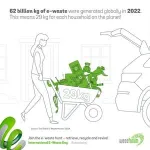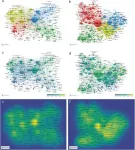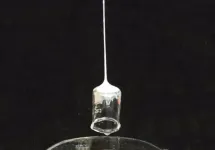(Press-News.org) To mark the upcoming International E-Waste Day, Oct. 14, consumers worldwide are urged to collect dead and/or unused electronics and electrical products and give them a second life through reuse or repair, or recycle them properly.
Above all: stop tossing them out in household waste bins.
The Global E-waste Monitor 2024, authored by UNITAR in cooperation with ITU, reported almost a quarter of end-of-life electronic waste ends up in home trash, squandering billions of dollars worth of copper, gold and other precious metals, materials critical to the production of such products, along with valuable plastics, and glass.
The 14 million tonnes of e-waste (dead or unused products with a battery or plug) discarded with ordinary household waste equals the weight of ~24,000 of the world's heaviest passenger aircraft – enough to form an unbroken queue of giant planes from London to Helsinki, NY to Miami, Cairo to Tripoli, or Bangkok to Calcutta.
Says Pascal Leroy, Director General of the Brussels-based Waste Electrical and Electronic Equipment (WEEE) Forum: "Small electronic and electrical goods such as mobile phones, toys, remote controls, game consoles, headphones, lamps, screens and monitors, heating and cooling equipment, and chargers are everywhere. And electronic components embedded in consumer products large and small – even clothing – are now omnipresent. The 844 million e-cigarettes thrown away in 2022 alone contained enough lithium, for example, to power 15,000 electric cars.”
Adds Magdalena Charytanowicz of the WEEE Forum in charge of International E-Waste Day:"We know what to do, and we can do better."
Ms. Charytanowicz says the place to start is the junk drawer, a common feature of homes around the world.
Globally, there are 108 mobile phone subscriptions per 100 people. And earlier surveys have shown that European households alone store about 700 million unused or non-functioning mobile phones – an average of more than two per household.
Why people hoard
She adds that "hoarding is an issue predominantly in wealthier countries. Elsewhere, reasons for keeping appliances are often personal data concerns or a desire to recover some of their value."
A 2022 survey helped explain why so many EU households and businesses fail to bring WEEE in for repair or recycling.
Undertaken by WEEE Forum members – not-for-profit entities that collect e-waste from households and businesses on behalf of manufacturers, and consolidated by UNITAR’s Sustainable Cycles (SCYCLE) Programme, the survey showed the average European household contains 74 e-products, such as phones, tablets, laptops, electric tools, hair dryers, toasters and other appliances (excluding lamps). The survey sample included 8,775 households across a diverse group of European Union countries – Portugal, Netherlands, Italy, Romania and Slovenia – combined with a UK survey,
Of the 74 average total e-products, 13 were being hoarded (9 of them unused but working, 4 broken).
Top reasons for hoarding in Europe:
Might use it again in the future (46%)
Plan to sell / give it away (15%)
Has sentimental value (13%)
Might have value in the future (9%)
Don’t know how to dispose of it (7%)
Others include:
Didn't have time, forgot about it, does not take up too much space (3%)
Planned use in secondary residence (3%)
Presence of sensitive data (2%)
There is no incentive to recycle (1%)
Complementary research reveals what motivates people to recycle e-waste:
Knowledge – understanding where and how to dispose of e-waste and why our actions can make a difference;
Convenient collection points – making it easy for consumers to make the right gesture;
Compensation – some consumers are motivated by financial or other type of compensations;
Social norms – following what others do
Care for the environment – a growing concern for many;
Benefits to charities – doing something good for others, such as offering unused appliances for reuse, is a great motivator
People are often surprised by information about the positive CO2 impact of e-waste recycling or simply happy to have done the ‘right thing’. See videos at https://www.youtube.com/watch?v=QwqZMb95b3Q
Many Producer Responsibility Organisations (PROs) – members of the WEEE Forum – organise communication campaigns and provide collection points, now more than 183,000 in all. To date, PROs have collected, cleaned, and recycled or sent for refurbishment 41.6 million tonnes of WEEE, with 3.1 million tonnes collected in 2022.
Great progress is being made but everyone has a role to play as the volumes of e-waste generated grow rapidly, says Ms. Charytanowicz.
Urging people to Join the E-Waste Hunt -- Retrieve, Recycle and Revive -- the WEEE Forum outlined the Five Ws of E-Waste recycling:
What: Any product with a battery or plug.
Where: WEEE Forum members' collection points: weee-forum.org/members, or any other official e-waste collection point
Why: According to Global E-waste Monitor 2024 (UNITAR / ITU):
Global e-waste management reduces CO2 equivalent emissions by 93 billion kg annually, equivalent to the annual emissions of more than 20 million cars
Proper e-waste recycling avoids leakages of harmful substance such as lead or cadmium to the environment
In 2022, e-waste produced globally contained approximately 4 billion kg of metals classified as critical raw materials, including 3.9 billion kg of aluminium, 34 million kg of cobalt, and 28 million kg of antimony
Recovering and reusing secondary raw materials from e-waste in 2022 avoided the need to mine 900 million tonnes of ore (the weight of 17,200 Titanics)
Who: You
When: Now
Says Cosmas Luckyson Zavazava, Director, ITU Telecommunication Development Bureau: “Almost 80% of the world's population today own a mobile phone. Among them, there are those who have several devices, in some cases, each with its own type of chargers, cables and accessories. I call on everyone to ensure the proper recycling of these devices, which is key to reducing their environmental impact and minimizing resource scarcity.”
“We need to keep monitoring the development in the years to come, as the global rise of e-waste generation is outpacing the formal collection and recycling by five times since 2010,” said Kees Baldé, Senior Scientific Specialist at UNITAR SCYCLE, and a lead researcher behind the Global e-Waste Monitor.”
* * * * *
International e-Waste Day (#ewasteday)
Last year, over 195 organisations from 55 countries supported the 4th International E-Waste Day observance. This year, the WEEE Forum invited all organisations involved in effective and responsible e-waste management to plan awareness-raising activities for 14 October. These range from social media, TV and radio campaigns to city or school e-waste collections or even artistic performances.
www.internationalewasteday.com
WEEE Forum
The WEEE Forum (a.i.s.b.l.*) is a Brussels-based for-impact association representing 53 sector-mandated producer responsibility organisations (PROs) worldwide. Through our members’ collective knowledge of the technical, business and operational aspects of collection, logistics, de-pollution, processing, preparing for reuse, and reporting of e-waste, we are at the forefront of making extended producer responsibility an effective waste management policy. Our mission is to be the world’s foremost e-waste competence centre, excelling in the implementation of the circularity principle.
Member PROs are based in Europe, Oceania, Africa, Asia and the Americas: Australia, Austria, Belgium, Canada, Colombia, Czechia, Cyprus, Denmark, Italy, Greece, Georgia, France, Iceland, India, Ireland, Lithuania, Luxembourg, Malta, Moldova, Netherlands, New Zealand, Nigeria, North Macedonia, Norway, Poland, Portugal, Moldova, Romania, Slovakia, Slovenia, Spain, South Africa, Sweden, Switzerland and the United Kingdom.
Since their founding, the WEEE Forum’s producer responsibility organisations have collected, de-polluted and recycled or sent for preparation for re-use 41.6 million tonnes of WEEE. More than 3.1 million tonnes of this was collected in 2022.
(*) Association internationale sans but lucratif/international non-for-profit association
www.weee-forum.org
Correspondence: pascal.leroy@weee-forum.org
* * * * *
WEEE Forum member contacts (for national e-waste insights):
Australia: ANZRP, Carla Vasconi, carla.vasconi@anzrp.com.au
Austria: UFH, Stephanie Zsifkovits stephanie.zsifkovits@ufh.at
Belgium: Recupel, Annelies Evens annelies.evens@recupel.be
Bosnia and Herzegovina: ZEOS, Mahir Bjelonja mahir.bjelonja@zeos.ba
Canada: GO RECYCLE, Mylène Mercier mylene@gorecycle.com; EPRA, Jay Illingworth jay.illingworth@epra.ca; MARR, Chris Campbell, ccampbell@marrbccollab.ca
Colombia: EcoCómputo, Maria Camila Robayo comunicaciones@ecocomputo.com; Red verde, Néstor Hincapie jefaturatecnica@redverde.co
Cyprus: WEEE Cyprus, Stelios Athanasiou s.athanasiou@weeecyprus.com.cy
Czechia: ELEKTROWIN, Jan Marxt jan.marxt@elektrowin.cz
Denmark: elretur, Jesper Bøttcher jb@elretur.dk
France: Ecologic, Elisabeth Stefann esteffann@ecologic-france.com; ecosystem, Claire LEMARCHAND clemarchand@ecosystem.eco Soren, Nicolas Defrenne nicolas.defrenne@soren.eco
Greece: Appliances Recycling, Christiana Bochali cbochali@electrocycle.gr; FOTOKIKLOSI SA, Dimitra Kyriakopoulou kyriakopoulou@fotokiklosi.gr
Iceland: URVINNSLUSJODUR, Edda Andrésdóttir edda@irf.is
India: Karo Sambhav, Pranshu Singhal Pranshu@karosambhav.com
Ireland: WEEE Ireland, Robyn Macken robyn@weeeireland.ie
Italy: Cobat, Valentina Negri v.negri@cobatraee.it; PV CYCLE Italia, jan.clyncke@pvcycle.org; Erion, Alice Olgiati alice.olgiati@erion.it
Lithuania: EGIO, Iveta Šmigelskienė iveta@gia.lt
Luxembourg: Ecotrel, Saoussen Gouiaa communication@ecotrel.lu
Malta: WEEE Malta, Sergio Mallia sergio@weeemalta.org; WEEE Recycle, Mario Schembri mschembri@greenpak.com.mt
Moldova: MoldControl, Iulian Gamureac, i.gamureac@moldcontrol.md
Netherlands: Stichting OPEN (Wecycle), Danielle Elings Danielle.Elings@stichting-open.org
Nigeria: EPRON, Ibukun Faluyi info@epron.org.ng
North Macedonia: ElKolekt, Lidija Miloshevska, elkolekt@gmail.com
Norway: RENAS AS, Anja Rönesen anja.ronesen@renas.no; Norsirk, Guro Kjørsvik Husby guro@norsirk.no
Poland: ElektroEko, Anna Podsiadlo anna.podsiadlo@elektroeko.pl
Portugal: Electrão, Ana Matos ana.matos@electrao.pt
Romania: ARCwaste, Teodor Tobolcea teodor.tobolcea@arcwaste.ro; Asociatia ENVIRON, Roxana Puia roxana.puia@environ.ro; ECOTIC, Ema Cumpătă ema.cumpata@ecotic.ro
Slovakia: Envidom, Peter Valent peter.valent.pv@gmail.com
Slovenia: ZEOS, Ursa Dolinsek urska.dolinsek@zeos.si
South Africa: Circular energy, management@circular-energy.org; ERA, Ashley du Plooy ashley@eranpc.co.za
Spain: ECOLEC, Rafael Serrano rafael.serrano@ecolec.es; Recyclia, Enrique Santos esantos@recyclia.es; Ecotic, Raquel Ayora rayora@ecotic.es
Sweden: Recipo, Hugo Chorell hugo@recipo.com; El-Kretsen, Mårten Sundin marten.sundin@el-kretsen.se
Switzerland: Swico, Jakob Knauf jakob.knauf@swico.ch; SENS eRecycling, Nando Erne nando.erne@sens.ch
United Kingdom: REPIC Ltd, Hannah Graham hgraham@repic.co.uk : PV CYCLE UK, Alexia Tilgenkamp media@pvcycle.org
* * * * *
END
E-waste experts urge public: Stop trashing electronic products with ordinary garbage (International E-Waste Day)
14 tonnes of e-waste discarded with regular household garbage every year equals in weight ~24,000 of the world's heaviest passenger planes – enough to form a queue from London-Helsinki, NY-Miami, Cairo-Tripoli, Bangkok- Calcutta
2024-10-10
ELSE PRESS RELEASES FROM THIS DATE:
Hospitals that are understaffed for infection prevention and control have higher rates of infection, study says
2024-10-10
Hospitals that are Understaffed for Infection Prevention and Control Have Higher Rates of Infection, Study Says
Nearly 4 in 5 hospitals are not staffed at sufficient level to keep patients safe from preventable infections
Arlington, Va. — October 10, 2024 — Inadequate infection prevention and control staffing levels are associated with higher rates of healthcare-associated infections, according to a new study published today in the American Journal of Infection Control.
The study, conducted by the APIC Center for Research, Practice & Innovation, summarizes a pilot project to evaluate a new online calculator aimed at providing facility-specific recommendations ...
Study reveals 85% of women prefer choice between self-sampling and traditional cervical screening
2024-10-10
A new study led by researchers at Queen Mary University of London reveals women would welcome the option to choose between self-sampling and traditional screening done by a nurse or doctor for human papillomavirus (HPV)-based cervical screening.
The study, published in the Journal of Medical Screening, assessed a group of 2,300 women aged 24-65 who had collected their own samples alongside having their standard cervical screening in 38 GP practices across England. Participants were asked about their screening preference and their attitudes toward being offered a choice between ...
Global advances and future trends in cervical cancer research from 2013 to 2022
2024-10-10
With ongoing advancements in cervical cancer research, the global scientific community has gained a more comprehensive understanding of this significant threat to women's health. A research team led by Professor Weimin Kong has recently published a paper titled "Hotspots and frontiers in cervical cancer research: a bibliometric and visualization analysis from 2013 to 2022" in the internationally renowned journal Malignancy Spectrum. The study systematically analyzed the development trends and research hotspots in global cervical cancer research over the past decade using bibliometric methods.
The research ...
Inspired by Spider-Man, a lab recreates web-slinging technology
2024-10-10
Every kid who has read a comic book or watched a Spider-Man movie has tried to imagine what it would be like to shoot a web from their wrist, fly over streets, and pin down villains. Researchers at Tufts University took those imaginary scenes seriously and created the first web-slinging technology in which a fluid material can shoot from a needle, immediately solidify as a string, and adhere to and lift objects.
These sticky fibers, created at the Tufts University Silklab, come from silk moth cocoons, which are boiled in solution and broken down into their building block proteins called fibroin. ...
Applied Microbiology International’s 2024 Honorary Fellowship goes to Dr Chikwe Ihekweazu
2024-10-10
Applied Microbiology International (AMI) is delighted to announce that its 2024 Honorary Fellowship goes to Dr Chikwe Ihekweazu, who is Assistant Director General at the World Health Organization (WHO), leading the WHO Hub for Pandemic and Epidemic Intelligence.
AMI Honorary Fellowships are given to individuals who have made an outstanding contribution to or impact on the field of applied microbiology. Honorary Fellows of AMI are nominated and chosen each year by the organisation’s membership.
Chikwe ...
Pitt scientists validate new lab test platform for blood biomarkers of Alzheimer's disease
2024-10-10
University of Pittsburgh scientists independently validated a new blood test platform that can simultaneously measure more than a hundred biomarkers of Alzheimer's disease. The platform might improve clinicians’ ability to capture the multifaceted nature of Alzheimer’s pathology and streamline early disease diagnostics. The report was published in Molecular Neurodegeneration today.
“Alzheimer’s disease should not be looked at through one single lens,” said senior author Thomas Karikari, Ph.D., M.Sc., assistant professor of psychiatry at Pitt. “Capturing aspects of Alzheimer’s pathology in a panel of clinically validated biomarkers would increase ...
No bolts about it: New technology improves structural strength
2024-10-09
In a collaborative effort between Texas A&M University and Sandia National Laboratories, researchers have significantly improved a new joining technology, interlocking metasurfaces (ILMs), designed to increase the strength and stability of a structure in comparison to traditional techniques like bolts and adhesives, using shape memory alloys (SMAs). ILMs offer the potential to transform mechanical joint design in manufacturing for aerospace, robotics and biomedical devices.
“ILMs are poised to redefine joining technologies ...
Medical professionals must lead the fight against climate misinformation
2024-10-09
Medical professionals have a responsibility to lead the fight against climate misinformation to ensure that the public is well informed about the health risks posed by climate change, say experts in The BMJ today.
Misinformation (inaccurate information spread without malicious intent) and disinformation (deliberately deceptive information) in health is not new, write Professor Andy Haines and colleagues.
Just as the rapid spread of false information during the covid-19 pandemic undermined public trust in science and public health interventions, false information also pervades the climate change debate, influencing public perception and ...
Should doctors be suspended for unlawful climate activism?
2024-10-09
Former GP Sarah Benn was suspended by the medical practitioners tribunal service (MPTS) after an arrest for her involvement in climate protests. In The BMJ today, two experts debate the question of when and whether doctors in such cases should be sanctioned.
The recent case of Sarah Benn has sparked debate, partly because of a perception that the GMC referred her to a MPTS tribunal for taking part in peaceful protests, says Andrew Hoyle, assistant director at the GMC.
In reality, he explains ...
Extreme rainfall linked to heightened risk of death
2024-10-09
Extreme rainfall events are associated with an increased risk of death from all causes as well as from heart and lung diseases, finds an analysis of data from 34 countries and regions published by The BMJ today.
The health effects of extreme rainfall varied by local climate and vegetation coverage, providing a global perspective on the effect of extreme rainfall events on health.
Climate change is intensifying the frequency and severity of short term rainfall events, and emerging evidence suggests a compelling link between rainfall events and adverse health outcomes, particularly transmission ...
LAST 30 PRESS RELEASES:
Why nail-biting, procrastination and other self-sabotaging behaviors are rooted in survival instincts
Regional variations in mechanical properties of porcine leptomeninges
Artificial empathy in therapy and healthcare: advancements in interpersonal interaction technologies
Why some brains switch gears more efficiently than others
UVA’s Jundong Li wins ICDM’S 2025 Tao Li Award for data mining, machine learning
UVA’s low-power, high-performance computer power player Mircea Stan earns National Academy of Inventors fellowship
Not playing by the rules: USU researcher explores filamentous algae dynamics in rivers
Do our body clocks influence our risk of dementia?
Anthropologists offer new evidence of bipedalism in long-debated fossil discovery
Safer receipt paper from wood
Dosage-sensitive genes suggest no whole-genome duplications in ancestral angiosperm
First ancient human herpesvirus genomes document their deep history with humans
Why Some Bacteria Survive Antibiotics and How to Stop Them - New study reveals that bacteria can survive antibiotic treatment through two fundamentally different “shutdown modes”
UCLA study links scar healing to dangerous placenta condition
CHANGE-seq-BE finds off-target changes in the genome from base editors
The Journal of Nuclear Medicine Ahead-of-Print Tip Sheet: January 2, 2026
Delayed or absent first dose of measles, mumps, and rubella vaccination
Trends in US preterm birth rates by household income and race and ethnicity
Study identifies potential biomarker linked to progression and brain inflammation in multiple sclerosis
Many mothers in Norway do not show up for postnatal check-ups
Researchers want to find out why quick clay is so unstable
Superradiant spins show teamwork at the quantum scale
Cleveland Clinic Research links tumor bacteria to immunotherapy resistance in head and neck cancer
First Editorial of 2026: Resisting AI slop
Joint ground- and space-based observations reveal Saturn-mass rogue planet
Inheritable genetic variant offers protection against blood cancer risk and progression
Pigs settled Pacific islands alongside early human voyagers
A Coral reef’s daily pulse reshapes microbes in surrounding waters
EAST Tokamak experiments exceed plasma density limit, offering new approach to fusion ignition
Groundbreaking discovery reveals Africa’s oldest cremation pyre and complex ritual practices
[Press-News.org] E-waste experts urge public: Stop trashing electronic products with ordinary garbage (International E-Waste Day)14 tonnes of e-waste discarded with regular household garbage every year equals in weight ~24,000 of the world's heaviest passenger planes – enough to form a queue from London-Helsinki, NY-Miami, Cairo-Tripoli, Bangkok- Calcutta






